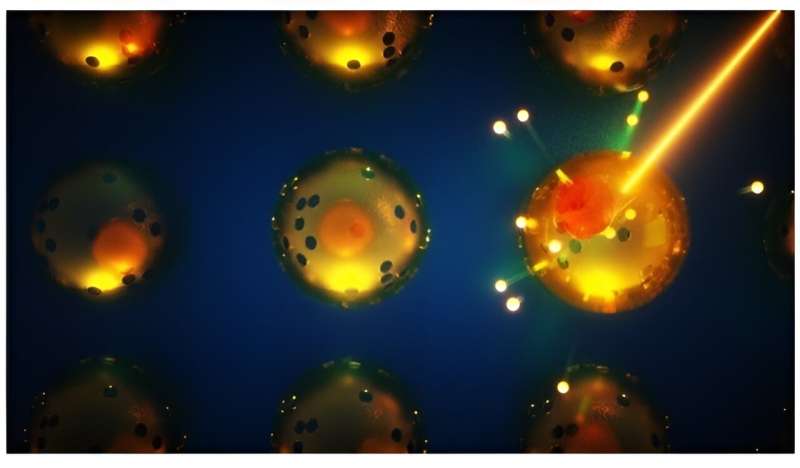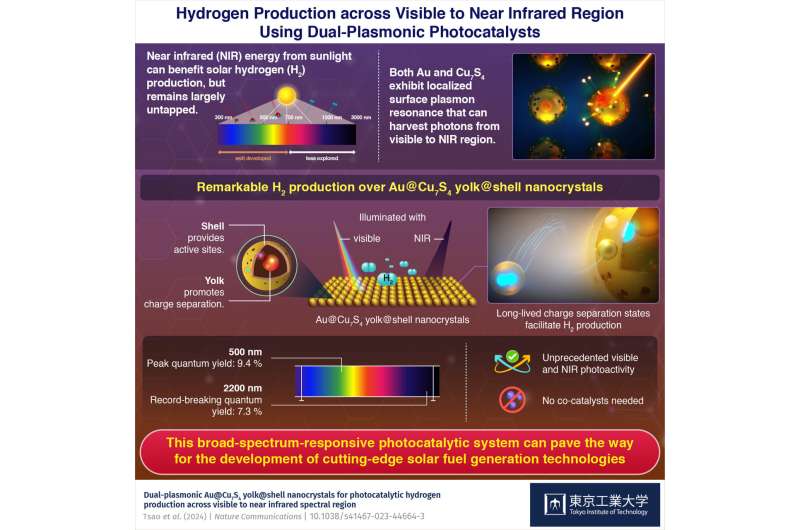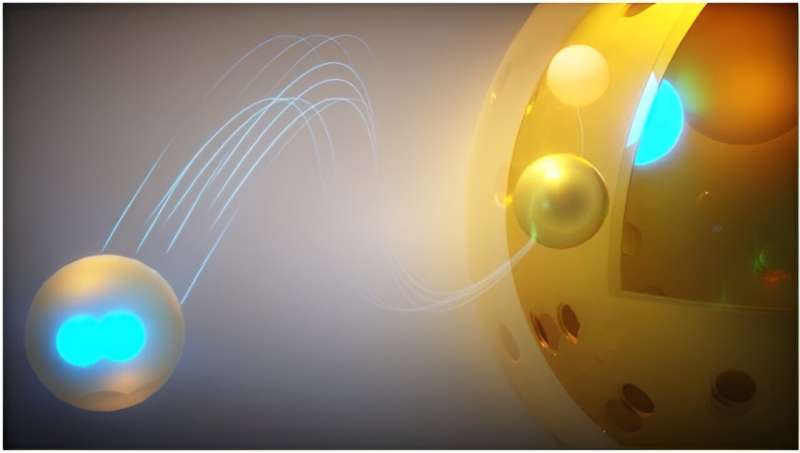This article has been reviewed according to Science X's editorial process and policies. Editors have highlighted the following attributes while ensuring the content's credibility:
fact-checked
peer-reviewed publication
trusted source
proofread
Nanocrystals set new hydrogen production activity record under visible and near-infrared irradiation

The sunlight received by Earth is a mixed bag of wavelengths ranging from ultraviolet to visible to infrared. Each wavelength carries inherent energy that, if effectively harnessed, holds great potential to facilitate solar hydrogen production and diminish reliance on non-renewable energy sources. Nonetheless, existing solar hydrogen production technologies face limitations in absorbing light across this broad spectrum, particularly failing to harness the potential of near infrared (NIR) light energy that reaches Earth.
Recent research has identified that both Au and Cu7S4 nanostructures exhibit a distinctive optical characteristic known as localized surface plasmon resonance (LSPR).
It can be precisely adjusted to absorb wavelengths spanning the visible to NIR spectrum. A team of researchers, led by Associate Professor Tso-Fu Mark Chang and Lecturer Chun-Yi Chen from the Tokyo Institute of Technology, and Professor Yung-Jung Hsu from National Yang Ming Chiao Tung University, seized this possibility and developed an innovative Au@Cu7S4 yolk@shell nanocrystal capable of producing hydrogen when exposed to both visible and NIR light.
Their findings are published in Nature Communications.
"We realized that wide-spectrum-driven hydrogen production is gaining momentum in recent days as a potential green energy source. At the same time, we saw that there were not many currently available options for photocatalysts that could respond to NIR irradiation," say Dr. Hsu and Dr. Chang. "So, we decided to create one by combining two promising nanostructures, i.e., Au and Cu7S4, with tailorable LSPR features."

The research team utilized an ion-exchange reaction for the synthesis of Au@Cu7S4 nanocrystals, which were subsequently analyzed using high-resolution transmission electron microscopy, X-ray absorption spectroscopy, and transient absorption spectroscopy to investigate the structural and optical properties.
These investigations confirmed that Au@Cu7S4 features a yolk@shell nanostructure endowed with dual-plasmonic optical properties. Furthermore, ultrafast spectroscopy data revealed that Au@Cu7S4 maintained long-lived charge separation states when exposed to both visible and NIR light, highlighting its potential for efficient solar energy conversion.
The research team discovered that the yolk@shell nanostructures inherent to the Au@Cu7S4 nanocrystals notably enhanced their photocatalytic capabilities.
"The confined space within the hollow shell improved the molecular diffusion kinetics, thereby augmenting the interactions among reactive species. Additionally, the mobility of the yolk particles played a crucial role in establishing a homogeneous reaction environment as they were able to agitate the reaction solution effectively," explains Dr. Chen.

Consequently, this innovative photocatalyst reached a peak quantum yield of 9.4 % in the visible range (500 nm) and achieved a record-breaking quantum yield of 7.3 % in the NIR range (2200 nm) for hydrogen production. Distinctively, unlike conventional photocatalytic systems, this novel approach eliminates the need for co-catalysts to enhance hydrogen production reactions.
Overall, the study introduces a sustainable photocatalytic platform for solar fuel generation that boasts remarkable hydrogen production capabilities and sensitivity to a broad spectrum of light. It showcases the potential of leveraging the LSPR properties of Au and Cu7S4 for the effective capture of previously untapped NIR energy.
"We are optimistic that our findings will motivate further investigations into tweaking the LSPR properties of self-doped, nonstoichiometric semiconductors, aiming to create photocatalysts responsive across a wide spectrum for a variety of solar-powered applications," conclude Dr. Hsu and Dr. Chang.
More information: Chun-Wen Tsao et al, Dual-plasmonic Au@Cu7S4 yolk@shell nanocrystals for photocatalytic hydrogen production across visible to near infrared spectral region, Nature Communications (2024). DOI: 10.1038/s41467-023-44664-3
Journal information: Nature Communications
Provided by Tokyo Institute of Technology





















